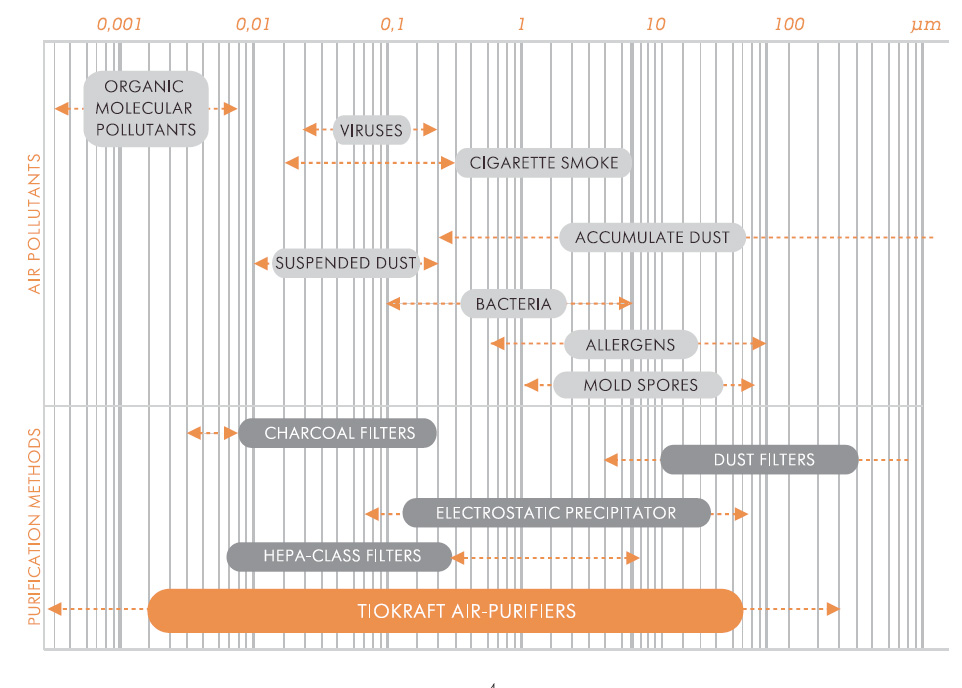Advantages of our
system
-
Purification against
thin aerosol without
HEPA-filter using -
Effectively molecular
purification
without absorbents using -
Air disinfect
without
hard UV-rays
WHAT WE’RE DEALING WITH?
All air pollutants can be divided by particle size. According to the European Environmental Agency (EEA) the nanoscale particles are the most dangerous to people. These include the molecular organic compounds that can get directly into the bloodstream (4-20 nm), the protein macromolecules of the major causative agents of acute allergies (20-40 nm), solid and liquid aerosol nanoparticles that aren’t removable by lungs (20-100 nm), viruses (20-300 nm), bacteria (from 100 nm).
The considerable improvement of the quality of air purification from the nanoscale particles is also determined by the development of a number of high-technology productions in microelectronics, pharmaceutics, medicine and biology.
THE CAPABILITIES
OF THE TRADITIONAL
METHODS OF AIR PURIFICATION
ARE GENERALLY RELATED
TO THE PARTICLE FILTRATION.
ANY FILTERING IN THE RANGE
BELOW 30NM IS NOT EFFECTIVE.
TODAY’S MOST COMMON WAYS OF AIR FILTRATION ALL HAVE THEIR OWN DISADVANTAGES.
CHARCOAL FILTER
Charcoal filters fundamentally aren’t able to purify the air of volatile compounds with a molecular weight less than 40 u (unified atomic mass unit). This means that such dangerous substances as formaldehyde (H2CO), methane (CH4), sulfur dioxide (H2S) and nitrogen dioxide (NO2) can’t be blocked by charcoal filters. As a result of the accumulation of toxins and dust a filter itself can become a source of contamination.
ELECTROSTATIC PRECIPITATOR
Their efficiency depends on the voltage of ionization and the geometry of precipitating electrodes. With the voltage above 7 kW electrostatic precipitators start to generate an ozone-toxic compound with very low values of MPC (0.02 mg/m3). Ozone on its own is hard to catch, that’s why the electrostatic filters have low ionization voltage and, therefore, aren’t effective at capturing aerosol particles.
HEPA-CLASS FILTERS
HEPA-class filters only capture particles larger than 300 nm, which doesn’t solve the issue of removing the most dangerous nanoparticles. Meanwhile all separated microflora is being concentrated on the filters.
OZONATOR
Ozonators’ abilities to oxidize the pollutants like pollen, dust, carbon oxide, formaldehyde are frankly speaking exaggerated. Ozone’s ability to oxidation in concentrations levels of 0.2-0.4 mg/m3 can't be effective because the inhibitory action on microflora can only be possible at considerably higher (10-20 times) concentrations which are extremely dangerous for people.
THE FUNDAMENTAL RESTRICTIONS OF THE ABOVE FILTRATION METHODS FORCE MANUFACTURERS TO SUPPLEMENT THEIR DEVICES WITH ADDITIONAL OPTIONS SUCH AS ANTIBACTERIAL FILTER TREATMENT, HARD UV-RADIATION, "PLASMA CLEAN”, ETC.
all drawbacks of existing
methods of air purification,
making a new step in the field
of using photocatalythic technologies
We know how to:
- purify the air from all aerosol particles, bacteria, viruses and mold spores of size from 30nm with the efficiency close to 100% in a single session
- remove any organic compounds including the ones with atomic weight less than 40 u
- completely inactivate all types of pathogenic microflora
- preclude ozone, carbon monoxide, ammonia, nitrogen oxide
Our innovation
consists of:
- combined usage of photocatalysis, corona discharge and coal adsorption advantages
- usage of high-capacity UV-radiation
- usage of high-efficiency electro-filter with unipolar deposition of charged particles on the dielectric fibers
- main filter blocks self-cleaning
THE EFFICIENCY OF THE PHOTOCATALYSIS
PRACTICE DEPENDS ON THE CORRECT
SCHEME OF ITS APPLICATION,
THE UV-RADIATION POWER
AND THE QUALITY OF THE
PHOTOCATALYST AND
ITS CARRIER
The carrier is a key element of the successful photocatalysis appliance
in general. It should have a porous structure, be made of inorganic
materials, provide good adhesion of the photocatalytic powder
and have a constructive strength and form, that would allow
to provide maximum capture of UV-radiation.
The surface of carrier after the first stage of its treatment - sintering. Beads size - 1,0 mm
The surface of carrier
after special treatment.
A CARRIER OF THE PHOTOCATALYST
(PATENT № RU 2151632 C1)
THE MANUFACTURING PROCESS OF THE PHOTOCATALYST’S CARRIER MADE OF POROUS GLASS IS ABSOLUTELY ECOLOGYCALY- FRIENDLY AND ALLOWS TO GET THE PHOTOCATALYTIC ELEMENTS OF DIFFERENT FORMS AND SIZES.
News
-
21 Aug 2019

Cholee Air Solution has been appointed the exclusive distributor of Tiokraft products in the region of Korea, China and ACEAN.
Cholee Air Solution has been appointed the exclusive distributor of Tiokraft products in the region of Korea, China and ACEAN.
Details
Based on the signed Agreement, Cholee Air Solution launched the production of air disinfectants using
photocatalytic elements "Tiokraft". -
2 Oct 2015

TIOKRAFT air cleaning systems testing in Germany
The microbiological tests of air purification system TIOKRAFT have successfully passed in September 2014 based on the EasternBavarian University.
Details -
8 Sep 2015

TIOKRAFT VR 400 test results at the National Institute for Occupational Health, Johannesburg, South Africa
The National institute for occupational health in Johannesburg (1 Modderfontein Road, Sandringham, Johannesburg, South Africa) made a complex test of the TIOKRAFT VR 400 for disinfection of the air containing various mycobacteria, including tuberculosis (Mycobacterium tuberculosis) MTB H37Ra during 6 months.
Details
